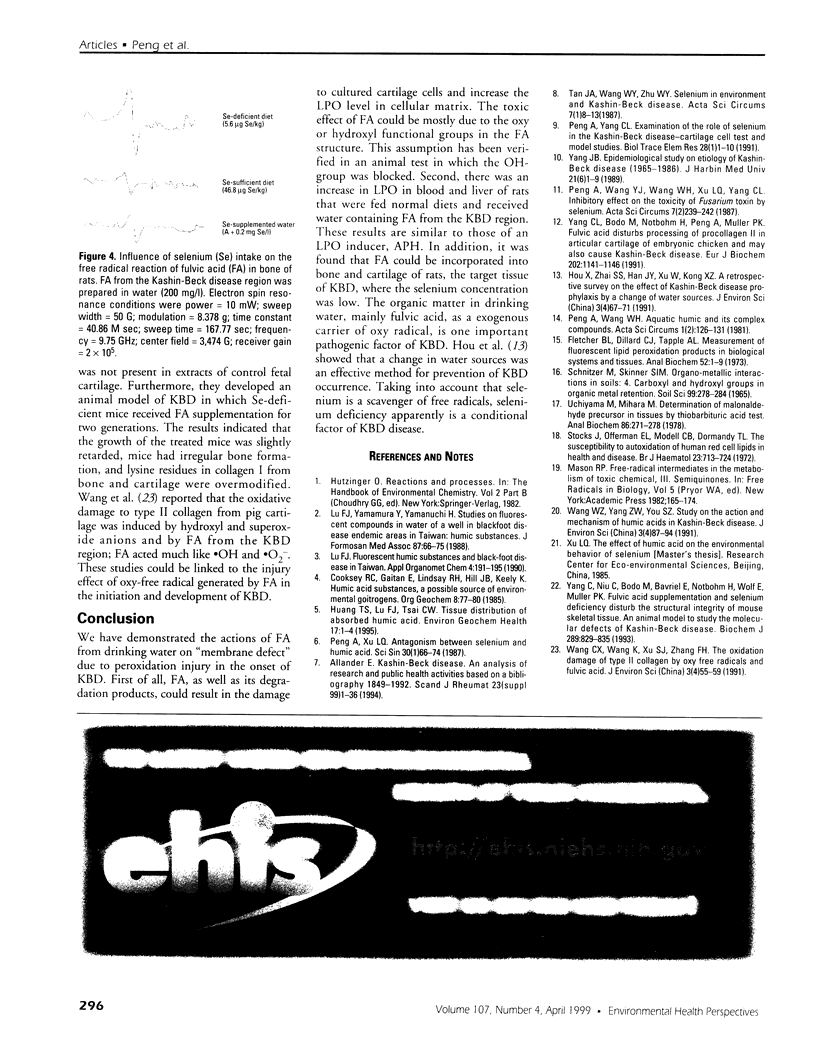Abstract
We conducted in vitro and in vivo assays in a selenium-deficient system to determine if organic matter (mainly fulvic acid; FA) is involved in a free radical mechanism of action for Kashin-Beck disease. Cartilage cell culture experiments indicated that the oxy or hydroxy functional groups in FA may interfere with the cell membrane and result in enhancement of lipid peroxidation. Experiments with rats demonstrated that toxicity from FA was reduced when the hydroxy group was blocked. Induction of lipid peroxidation by FA in liver and blood of rats was similar to that exhibited by acetyl phenyl hydrazine. FA accumulated in bone and cartilage, where selenium rarely concentrates. In addition, selenium supplementation in rats' drinking water inhibited the generation of oxy-free radicals in bone. We hypothesized that FA in drinking water is an etiological factor of Kashin-Beck disease and that the mechanism of action involves the oxy and hydroxy groups in FA for the generation of free radicals. Selenium was confirmed to be a preventive factor for Kashin-Beck disease.
Full text
PDF



Images in this article
Selected References
These references are in PubMed. This may not be the complete list of references from this article.
- Fletcher B. L., Dillard C. J., Tappel A. L. Measurement of fluorescent lipid peroxidation products in biological systems and tissues. Anal Biochem. 1973 Mar;52(1):1–9. doi: 10.1016/0003-2697(73)90327-8. [DOI] [PubMed] [Google Scholar]
- Lu F. J., Yamamura Y., Yamauchi H. [Studies on fluorescent compounds in water of a well in blackfoot disease endemic areas in Taiwan: humic substances]. Taiwan Yi Xue Hui Za Zhi. 1988 Jan;87(1):66–75. [PubMed] [Google Scholar]
- Mihara M., Uchiyama M. Determination of malonaldehyde precursor in tissues by thiobarbituric acid test. Anal Biochem. 1978 May;86(1):271–278. doi: 10.1016/0003-2697(78)90342-1. [DOI] [PubMed] [Google Scholar]
- Peng A., Xu L. Q. Antagonism between selenium and humic acid. Sci Sin B. 1987 Jan;30(1):66–74. [PubMed] [Google Scholar]
- Stocks J., Offerman E. L., Modell C. B., Dormandy T. L. The susceptibility to autoxidation of human red cell lipids in health and disease. Br J Haematol. 1972 Dec;23(6):713–724. doi: 10.1111/j.1365-2141.1972.tb03486.x. [DOI] [PubMed] [Google Scholar]
- Yang C. L., Bodo M., Notbohm H., Peng A., Müller P. K. Fulvic acid disturbs processing of procollagen II in articular cartilage of embryonic chicken and may also cause Kashin-Beck disease. Eur J Biochem. 1991 Dec 18;202(3):1141–1146. doi: 10.1111/j.1432-1033.1991.tb16482.x. [DOI] [PubMed] [Google Scholar]
- Yang C., Niu C., Bodo M., Gabriel E., Notbohm H., Wolf E., Müller P. K. Fulvic acid supplementation and selenium deficiency disturb the structural integrity of mouse skeletal tissue. An animal model to study the molecular defects of Kashin-Beck disease. Biochem J. 1993 Feb 1;289(Pt 3):829–835. doi: 10.1042/bj2890829. [DOI] [PMC free article] [PubMed] [Google Scholar]





